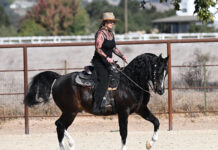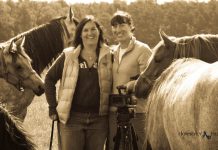Lodge Farm Arabians was, undoubtedly, the pinnacle of Arabian breeding in the UK. Founded by Joanna Maxwell along with her husband, the late Major Pat Maxwell, the horses bred at this stud have almost become a bloodline in their own right. ‘Maxwell lines’ is a commonplace term the world over and in May 2011, we dedicated an edition to this breeding programme. In this feature by Joanna and Pat’s daughter, Emma, she shares her recollections of Lodge Farm and the remarkable Arabian horses that came from this small corner of England.
The first horse bought by Joanna was Kazra (Mikeno x Razehra) in 1962 as a yearling filly for £400. The average price for a house in 1962 was £2,900, so this was a substantial sum. It was double Joanna’s originally planned amount, which is not an unusual story, but Kazra was found after an extensive search and advice that we were given and have never failed to give new breeders: that you are far better to buy one good filly than several average ones.
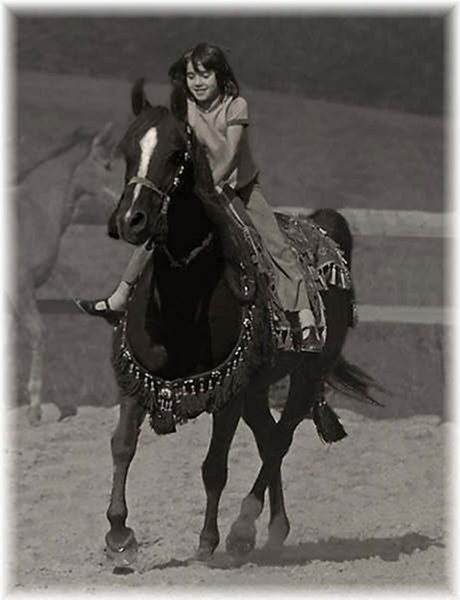
Emma on Kazra (Mikeno x Razhera), the foundation mare of Lodge Farm
During the 1960s, the stud was a one-mare outfit, as many small breeders are today, but with one difference emblematic of the times; a colt was also bought as breeding partner for the mare. For the colt, Joanna went one of the top show breeders in the UK of those times, Jill Thomas, and bought a yearling. For this purchase she took an expert with her to make sure she was buying a good enough colt to keep as a stallion. Indriss (ex Rissalma) was a son of Indian Magic, then the most impressive individual at the Crabbet Arabian Stud. Until comparatively recently, it was very common for breeders to have their own stallion. Most breeders then continued until they were saturated with that blood and then bought another unrelated one, or used other people’s stallions in the hopes of breeding a colt for their own programme. Whether this was better or worse for breeding looked at overall is a question that the jury is still out on. The disadvantage of every breeder having their own stallions was that not all of them were high quality and high quality features were thinly spread through the population. The advantage was that genetic variety was maintained much better and the spread of faults and problems was also spread very thinly through the population. Today, one might point to the incidence of narrow or upright or twisted and uneven-sized feet spreading like wildfire through the show Arabian population as an unintended consequence of these undesirable features being present in several of the most popular sires of the recent past.

Kazminda (Indriss x Kazra), British National Champion
Indriss and Kazra produced the stud’s first National Champion, the foal Kazminda in 1970. A gap of seven years from first horse to first National Champion might seem daunting to an ambitious new breeder, but it is not that unusual. It takes 10 years to set a direction, and another 10 to 20 to bring that those ideas to their peak. Kazminda had to beat 45 foals that year. She then founded a dynasty of her own, mainly early maturing bright chestnuts that spent much of the next two decades winning National Championships and many of the studs’ first prizes won at the Salon du Cheval. Kazra and Kazminda won the Princess Muna Saddle of Honour for best family group five times. Kazminda also had a full sister, liver chestnut Muzri, who was less dramatically successful at the time. However she more than proved her worth with her grandson Maleik el Kheil (though her daughter, Muneera by Fakhr el Kheil) and her direct descendants are still in France, where Lodge Farm is based today. Muzri was sold to Mary Ann Wragg and founded another dynasty of superb riding horses with the Horse of the Year Show Pure-bred Ridden Arabian winner Muzonomy (Golden Samurai x Muzehraa out of Muzri) just one of the highlights.

Kazra wearing her Princess Muna Saddle of Honour
Shortly after the Crabbet Stud announced its final dispersal, at the sale a second son of Indian Magic was bought – more of a lookalike than Indriss – Indian Silver. Indian Silver was used comparatively lightly before his export to the USA in 1976, but he became the only Crabbet stallion to bridge the gap between ancient and modern by siring a Paris World Champion in the form of Aliha (ex AK Atallah). The gap now between Crabbet and Salon de Cheval success has now widened to a chasm and Crabbet Arabians are scoffed at these days by show aficionados – and vice versa; both, one might add, with perfectly valid reasons.

Indian Silver (Indian Magic x Dalika)
It is noticeable today that different sections of the Arabian breed have specialised either by building bloodline barriers that fence off arbitrary selections of Arabians into inward-looking cliques, or by concentrating on one competitive aspect of their product over and above any other. Hence ‘Crabbet’ Arabians are now, 50 years since Lady Wentworth died, still tied to her choices of import and are governed by the genes those imports have given them. While Crabbet Arabians have historically and still do excel under saddle, mainly as a result of good movement at all three paces, they have no opportunity to work on their weaker features with new genes and no answer to any problems closed breeding may throw up. Meanwhile ‘show’ horses are slowly becoming a type of horse suitable only for in-hand showing as they have specialised in beauty, refinement and presence, while legs and feet have become commonly regarded as poorly judged and insignificant to the success of your show horse. As an aside, it is interesting to note that British judges are less inclined to sideline conformation, probably as a consequence of having to judge part-bred and Anglos as part of the exam. Judging the derivative breeds is more of an exercise in pure assessment of equine conformation and it concentrates the mind more thoroughly on conformation when the spotlight then falls back on the pure-bred.
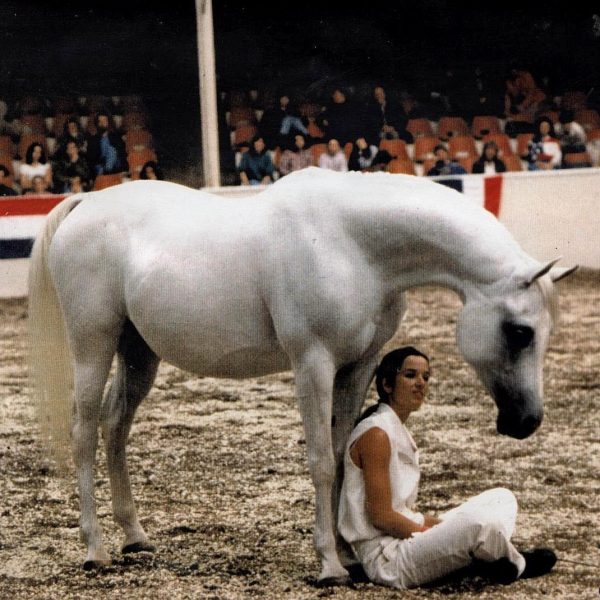
The wonderful mare Aliha, a cross of Crabbet over Egyptian
The prevailing feeling in England at the time of Lodge Farm’s early days was that England was the centre of the Arabian breeding universe. However, the English horses of the day still didn’t quite give Joanna the feeling that she was breeding the most Arabian type of horse that there was. Some pictures Judi Forbis took at the Egyptian State Stud, the EAO, sparked an interest in these horses and Pat and Joanna made their way to Egypt in 1969, but all the horses they liked were snapped up by American buyers. Today, the Middle East has taken the role of the United States in making it very hard, but not impossible, for a smaller breeder to buy really good stock.

Fakhr el Kheil (Korayem x Bint Muneera) in 1974, the first Egyptian stallion bought by a UK breeder
In 1971, Pat and Joanna managed to buy a yearling colt and a filly foal – Fakhr el Kheil, a Nazeer grandson from Hamdan stables, and Bint Jehan, a Moniet el Nefous granddaughter – from the EAO. Neither horse could be imported into the UK without spending two years in quarantine, which they did in Belgium, and then the British Arab Horse Society registry refused to register them as pure-breds thanks to spelling transpositions when translating their pedigrees from Arabic. It took four years for Fakhr el Kheil’s paperwork to be accepted. Meanwhile, Pat had resigned from the Army to concentrate on horse breeding as business and it became imperative to have the best breeding stock possible. After a couple of years in transit, the Egyptian pair didn’t look quite up to the mark, especially Fakhr el Kheil who had had blood poisoning twice en route, and so Pat and Joanna decided to make sure they got the best of Egyptian bloodlines by going to the States. In 1972 a further breeding pair were selected, Shakhs, a Morafic foal from Gleannloch, and AK Attallah, an Ansata Ibn Halima daughter from Bentwood. AK Atallah was a $30,000 yearling in that time, an imposing price even today, and in fact she was the only Ibn Halima daughter to come to Europe until the well after the price crash in the late 1980s, Europeans being unable to stomach their price tags.

Shakhs
The Egyptians made a great contribution to Lodge Farm, and did put them on the map. The two American horses were sold back to the States as adults for six figures, AK Atallah leaving Aliha and Shakhs, Kazra el Saghira (ex Kazra), who spent her life at Lodge Farm. Shakhs also sired many champions in many countries, plus several race winners. Bint Jehan (Tuhotmos x Jehan) had five lovely colts, two of which were National Champion Stallions in their new countries and one plain filly, before she died in the US from colic, in foal to US National Champion Stallion Ansata Ibn Sudan. At the time, the legendary German stallion Jamill was not acceptable to the UK Studbook and shipped semen was far in the future, so she was sent to the States to be bred. Fakhr el Kheil had one line to Skowronek (Ibrahim x Jaskolka) and was spurned by The Pyramid Society, so he stayed at the farm and at the age of 13 years old, after his Paris win, was hijacked by the children as a splendid Pony Club one-day eventing mount, a role to which he rose to magnificently. Kheil’s outstandingly tolerant nature was passed on to his grandson Maleik el Kheil and beyond.

The European Champion Kazra el Saghira (Shakhs x Kazra), photographed here in 1989 and ridden by Emma
The Egyptian horses were so different looking to the Crabbets that none of the four ever won a first prize in the UK, although all four won their class or more at the Salon du Cheval. The Salon du Cheval was the next big adventure for the Lodge Farm breeding enterprise and was first attended in 1975. Bear in mind that there were no motorways, the truck was a wooden Bedford TK, customs took around a day, the ferries were less well stabilised and more inclined to leave you at the docks in any wind, and the size of the undertaking becomes more apparent. That first year they only took one colt, the Kazminda son Kazmeyn (by El Dajani), who was later sold to some new British breeders, Silverdale Arabians. Kazmeyn won his class without too much competition.
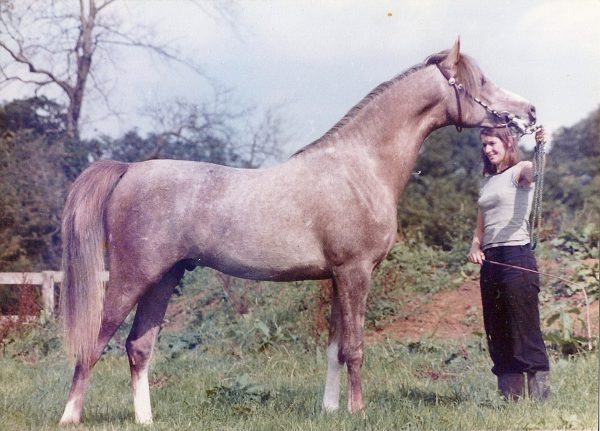
El Shaklan (Shaker el Masri x Estopa), British National Champion and International Champion in Belgium 1977
The following year they tried another international show at Vlimmeren in Belgium. At this show, a skinny grey yearling colt that placed fourth in his class caught their eye. They tried to buy him, but the wife refused and so they agreed a three-year lease. This colt was El Shaklan (Shaker El Masri x Estopa) and he swept all before him both in the UK and at the return to the Salon du Cheval in 1977 when he was Junior Male Champion, alongside Kazra el Saghira who was Junior Female. By 1977, many more Europeans and North Africans were in attendance at the show and by 1978, the State Studs of Poland and some of the big names in the US – Chauncey and Bentwood Arabians – were also competing. El Shaklan repeated his victory in 1978, with the yearling Aliha standing Reserve Junior Female and her dam Atallah Reserve Senior Mare, both to Janów entrants. It was not an exaggeration when the show bagged the title of the World Championships in 1980. This year, the high score of the show went to the yearling colt Maleik el Kheil (El Shaklan x Muneera by Fakhr el Kheil out of Muzri) and the Reserve World Champion Mare title was awarded to Bint Jehan with a 10-year-old Emma on the lead.
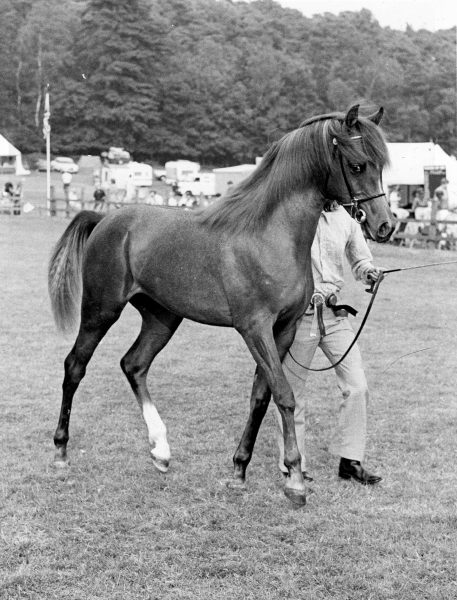
Maleik el Kheil (El Shaklan x Muneera) at Ascot in 1980
Lodge Farm has won more than any other private breeder at the Salon du Cheval with six World Championships, all won with horses they bred: Maleik el Kheil, the pure English Siwah (Shammar x Sappho), the straight Spanish Estepa (Ghadames x Esperada), Aliha (Indian Silver x AK Atallah) and Atlantica (El Shaklan x Aliha), who won as both junior and senior. Nine reserves were also collected with straight Egyptians Bint Jehan, AK Fanniya (Ansata Ibn Halima x Narimaan) and twice with Crusader (Salaa el Dine x AK Kastana); the pure Polish Czata (Banat x Cyrkulacja), and the homebreds Khashil (Maleik el Kheil x Khamala), Hamadahan (Maleik el Kheil x Hagunia), Amazonn (Pakistan x Atlantica) and Atlantica herself, who won a third World Championship title. In retrospect, it was great fortune to have won in the days before the Middle East were likely to buy anything with a chance of the top titles. The huge prices would have been appreciated by the always precarious finances of the farm, but we would have missed those triumphant lorry rides home, a homebred World Champion in the back, and a shiny gold saddle in the front. In fact in 1990, we came home with three of the saddles wedged into the front of the lorry, as Rumak (Partner x Rucasja) won his World Champion Stallion title for Paulo Gucci while at show livery on the farm and, like our own, was ridden around the local cross-country course to keep him fit and cheerful.
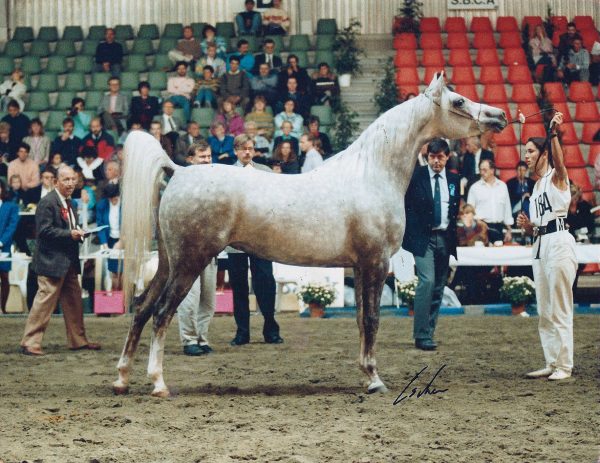
Atlantica (El Shaklan x Aliha), World and European Champion Mare. Photographed just out of race training. Credit Erwin Escher
The emergence of El Shaklan and his lovely dam Estopa opened another previously unexplored avenue in Arab breeding, that of Spain. Pat and Joanna lost no time in visiting Spain after seeing what they could produce and this time managed to get there before the Americans. Thus for the first time, they could also buy adult mares instead of just gambling on foals. However the Spaniards were not too keen on selling their finest, and most of the mares for sale usually had terrible breeding records; sorting out their problems was one of the things that made Joanna become one of the most respected non-veterinary gynaecology experts in Arabians. The best of the mares that came from Spain were probably the trio from Alfredo Erquicia, a cousin of the Domecq family. Jaiba (Garbo x Acacia) was dam of multiple Middle Eastern Champion Jerrash (by Maleik el Kheil) and Esperada (Tabal x Berlanga) dam of National Champion Esplendor, World Champion Estepa and the dual purpose ridden halter champion Ghandour, all by Ghadames. Hagunia (Jabalpur x Iama) founded a dynasty of champions that is still winning today; last year’s British National Champion Stallion FS Ronaldo (ex Helaliya) is a direct descendant crossed first with Maleik el Kheil blood and then his dam is by Crusader. In fact a similar recipe provided the dam of the Supreme British National Ridden Champion and UK International Ridden Champion ZA Karis Ibn Azal, also from 2010, except tracing to the 1977 Spanish import Kadina by Tabal; his dam is Azalea (by Crusader) out of the Maleik el Kheil daughter, Alazali.

Helaliya (Crusader x Heloua), has been a fantastic broodmare. Her get include FS Ronaldo (by Kubinec), 2010 British National Champion Stallion
Part two will be published next week.
For more features with The Arabian Magazine, click here.




